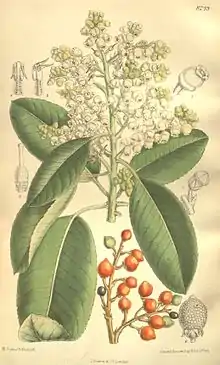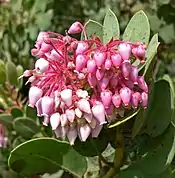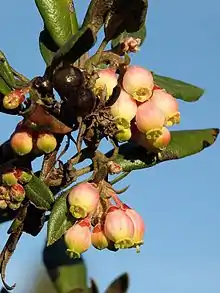Arbutoideae
The Arbutoideae are a subfamily in the flowering plant family Ericaceae. Phylogenetic analysis supported all genera of the subfamily as monophyletic, except Arbutus.[1] Moreover, it was suggested that the non-sister relationship between Mediterranean and North American species may be explained by a once widespread distribution in the Northern hemisphere before the Neogene.[1]
| Arbutoideae | |
|---|---|
 | |
| Arbutus menziesii | |
| Scientific classification | |
| Kingdom: | Plantae |
| Clade: | Tracheophytes |
| Clade: | Angiosperms |
| Clade: | Eudicots |
| Clade: | Asterids |
| Order: | Ericales |
| Family: | Ericaceae |
| Subfamily: | Arbutoideae Nied. |
| Type genus | |
| Arbutus | |
| Genera | |
The genera Arbutus, Arctostaphylos, Comarostaphylis form a particular type of mycorrhizal symbiosis with the fungus Arbutoid mycorrhiza, which resembles ectomycorrhizas.[2][3]
Genera List
| Image | Genus | Living Species |
|---|---|---|
.jpg.webp) | Arbutus L. |
|
 | Arctostaphylos Adans. |
|
_IMG_6699.JPG.webp) | Arctous (A.Gray) Nied. |
|
.jpg.webp) | Comarostaphylis Zucc. |
|
.jpg.webp) | Ornithostaphylos Small |
|
 | Xylococcus Nutt. |
|
References
- Hileman LC, Vasey MC, Parker VT (2001). "Phylogeny and biogeography of the Arbutoideae (Ericaceae): implications for the Madrean–Tethyan hypothesis". Systematic Botany. 26 (1): 131–143. doi:10.1043/0363-6445-26.1.131 (inactive 2021-01-06).CS1 maint: DOI inactive as of January 2021 (link)
- Osmundsen TW, Halling RE, den Bakker HC (2007). "Morphological and molecular evidence supporting an arbutoid mycorrhizal relationship in the Costa Rican páramo". Fungal Diversity. 17 (3): 217–222. doi:10.1007/s00572-006-0098-x. PMID 17216498. S2CID 19084561.
- Smith SE, Read D (2008). Mycorrhizal Symbiosis (3rd ed.). Amsterdam; Boston: Academic Press. ISBN 978-0-12-370526-6.
External links
 Data related to Arbutoideae at Wikispecies
Data related to Arbutoideae at Wikispecies- Arbutoideae in the Flora of North America
This article is issued from Wikipedia. The text is licensed under Creative Commons - Attribution - Sharealike. Additional terms may apply for the media files.